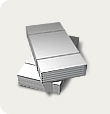Aluminum-composite panels are used as a material for decoration, advertising installations and pavilions. When milling such panels, expert adherence to the rules is required.
Work on advertising stands and facade cassettes :
- cutting the sheet, attaching the guide (25 cm longer than the workpiece) with clamps to the working surface, pressing the workpiece using the guide;
- groove processing. router recommended. His finger mill is also used in work with curved curves, small details, aluminum milling from point and without serif. In this type of milling cutter there is a revolving device, with the help of which the depth of insertion of the cutter is set and fixed. Use the controller to indicate the desired depth of cut, make a test run and measure the intact material layer, taking into account the polymer coating. The width of its residual layer is 3-4 mm. Observe the insertion depth of the cutter with the tracing roller. Keep dust, sawdust and shavings away from the roller. The bottom of the cutter must be at least 3 mm to create the desired bend radius.
- cross-section of the board grooves for the installation of hinges;
- bending along the milling line - the stiffer the board, the larger the bending angle should be. A cutter with a section angle of 90-110 ° will allow the sheet to bend 90 °, and a 135 ° cutter - and 45 °. Do not overweight the tensile strength over the permissible breaking strength of the aluminum, otherwise the panel will crack. In a router, a heel is required. The correct remainder of the polymer layer (not less than 3 and not more than 4 mm) after milling the groove will allow you to make the required rounding radius. With a panel 0.21-0.3 mm thick, the radius of its rounding will turn out to be 1.6-2 mm. To create a smooth bend in the sheet, find out the bending radius by measuring the thickness of the polymer layer. With a millimeter layer of polymer, the U-groove will be 14 mm wide.
- installation of hinges, rivets on the billboard box of the advertising structure.






